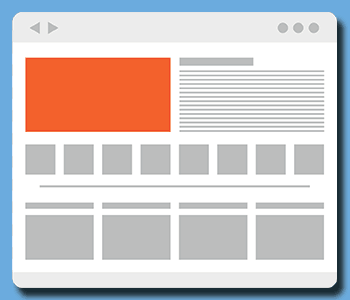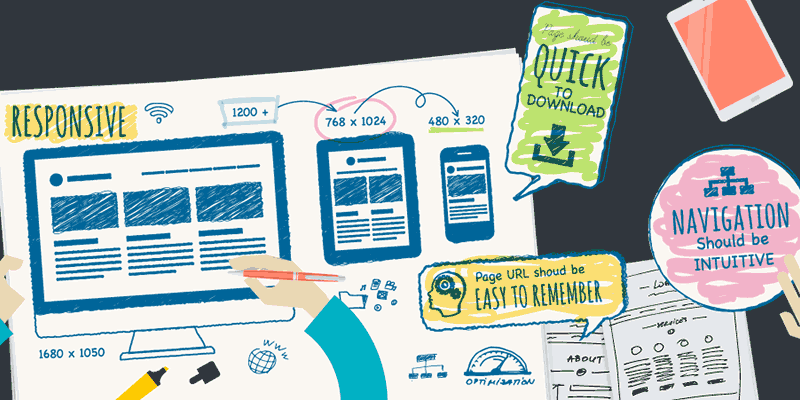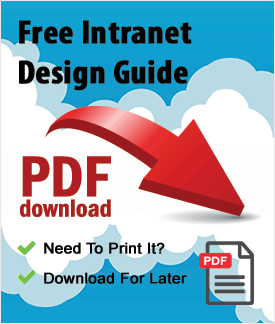If you don’t have much time to design your intranet, then intranet design templates offer the perfect solution. They make designing an intranet easy. On this page, we cover everything you need to know about intranet templates.
- Intranet Templates vs. Building From Scratch
- Why Intranet Templates Make Designing Your Intranet Easier
- Elements of an Intranet Template
- Customizing Your Intranet Templates
- How to Set Up Intranet Website Templates
- Intranet Templates in a Nutshell
Intranet Templates vs. Building from Scratch
Are you looking at an intranet template solution for your business? If the answer is yes, then this article is essential reading. As well as examining in detail what intranet templates are and how they work, we also look at the options available for setting one up. In fact, there are two main choices. The first is to build your own intranet template from scratch. And the second option is to subscribe to a SaaS or cloud-based intranet provider. Which decision you ultimately make will depend on the unique needs of your business, but there are a few factors that you should consider before diving in. This article will help you work through those factors so that you can make the best decision for your business. First though, let’s be clear about what intranet templates are and how they work.
Intranet Templates: What Are They And How Do They Work?
Basic intranet templates allow you to create a consistent look and feel for a corporate intranet. Coming complete with coding, a rudimentary design and basic graphics, intranet templates make the job of creating an intranet much easier as they can be customized to the exact requirements of your business. What’s more, the pre-built nature of the intranet template means that they are quick to set up and easy to deploy. Many companies are opting for intranet templates because of their flexibility and adaptability.

The Cost of Building Yourself
If you plan to design your own intranet from the ground up, you need to have the skills necessary to handle this complex undertaking. While it can be done with a lot of Google searching and a heavy dose of determination, the end cost of that kind of undertaking may surprise you: building from scratch could cost as much as $40,000 to make it work. The financial bottom line isn’t the only cost, however. Implementing your new intranet program could take as much as 15 months if you try to do it on your own. In some businesses, or if you’re tackling other assignments and problems at the same time, it could take even longer! One European study found that, depending on the size of the company, the number of employees the intranet is expected to cover, and the complexity required of the intranet service, it could require between 20 and 200 full workdays to implement the new intranet.
And so, the bottom line is that building your own intranet represents a considerable investment of both time and resources and you need to be prepared and fully signed up to that in advance.
The Process of Developing Your Own Intranet
Creating your own intranet starts with developing a set of requirements. Those requirements will determine the entire shape of the intranet for your business: the information, data and tools it will offer, how many people it will be able to support, and how well it will grow and develop with your business. Many people who might have the technological expertise to help with the project may find that they don’t have the skills necessary to determine exactly what components are necessary across the business as a whole.
 Next, you’ll need to find and engage a software company that will be able to meet your needs. There may be a lengthy interview process in order to determine whether or not a given company will adequately meet your requirements. Once you’ve chosen a company, you’ll have to wait for them to develop a product. Delays are fairly common, especially if you need to change your original template for some reason – including the possibility that your requirements are unclear or the software company has added something that you didn’t initially consider. There will also be a revisions process before your intranet is ready to launch. You’ll have to go through several trials before you can be sure that you’re ready to release the intranet to the company as a whole.
Next, you’ll need to find and engage a software company that will be able to meet your needs. There may be a lengthy interview process in order to determine whether or not a given company will adequately meet your requirements. Once you’ve chosen a company, you’ll have to wait for them to develop a product. Delays are fairly common, especially if you need to change your original template for some reason – including the possibility that your requirements are unclear or the software company has added something that you didn’t initially consider. There will also be a revisions process before your intranet is ready to launch. You’ll have to go through several trials before you can be sure that you’re ready to release the intranet to the company as a whole.
Building Your Own Intranet: The Challenges of Change
If you’ve chosen to create your own intranet from the ground up, you’re now handcuffed to the software company for any changes or additions to the existing structure. For example, if you want new features, need to increase the size of your intranet due to unforeseen growth within your organization, or you need to make changes to the way the intranet functions months or even years after launch, you have no choice but to go back to the original company. Your intranet will stand still from a growth perspective unless you pay for the privilege of additions.
Getting To The End Goal Quickly: SaaS/Cloud-Based Providers
Cloud-based/SaaS providers allow you to roll out your new intranet quickly. Because they come with an existing template, there’s no need to write code from scratch or to create a new product simply to fit the needs of your company. Because you aren’t starting from scratch, it will be much less expensive. Chances are the software company you’re considering will have many of the features you want. The possibility exists that you will have to compromise on a few features or accept some solutions that aren’t exactly what you had in mind and this is the necessary sacrifice of using an existing template instead of building from scratch. But you’ll also find that with some ingenuity, you can make the existing system work for you.
The Key To Choosing A SaaS Provider
 If you’re looking for a SaaS provider for your intranet, the first thing you want to consider is your ability to customize the product to the unique needs of your business. Flexibility in your provider and the software on offer is vital. The best solutions will allow you to add template pages to develop your site, then customize the content with apps or modules. Your business isn’t like any other out there, and your needs won’t be the same either. Don’t assume that all solutions are created equal! While saving money with a SaaS solution is one key reason to go with an existing provider instead of building your own intranet from scratch, you shouldn’t compromise on your ability to customize the intranet to your business needs.
If you’re looking for a SaaS provider for your intranet, the first thing you want to consider is your ability to customize the product to the unique needs of your business. Flexibility in your provider and the software on offer is vital. The best solutions will allow you to add template pages to develop your site, then customize the content with apps or modules. Your business isn’t like any other out there, and your needs won’t be the same either. Don’t assume that all solutions are created equal! While saving money with a SaaS solution is one key reason to go with an existing provider instead of building your own intranet from scratch, you shouldn’t compromise on your ability to customize the intranet to your business needs.
What You Need In A SaaS Provider
There are several characteristics of a strong intranet, and you will want to be sure that yours has them all. You need to be certain that the provider is implementing best practices across the board. Look into the flow, structure, and layout. Is the system easy to use? What’s the end user experience: not just for administrators, but also for the employees that are going to be using the system day in and day out? Remember, if the system is clunky, doesn’t flow well, or is slow to load, your employees will be less likely to use it and an intranet that isn’t being used defeats the entire purpose. Each time you consider a SaaS provider, ask to test drive the system with a free trial or a shared screen demo. Get several employees in your business to check it out, preferably from each level of the organization. That way you’ll get comprehensive feedback from a broad range of users within your business who may be utilizing the intranet in different ways. From the feedback supplied you’ll be able to gain an overview of the intranet’s workings that addresses the following questions. Does it fill the needs of everyone that it’s expected to serve? Does anyone have any complaints with the initial set up of the template? There’s only so much that customization can do for poor flow or a slow-loading system. You want your intranet to be able to support engaging user content, whether it’s text, video, graphics or photos that will interest your users throughout the lifetime of the system.
Where To Start
When you’re ready to decide where you’re going with your intranet, start by developing a plan. Ideally, you want to put together a site map that will define the structure of your intranet. Then, ask yourself how much customization you really need. Does your business have specific, unique needs that are unlike other businesses and which are unlikely to appear as part of a template? If not, you probably don’t need the customization of building an intranet from scratch. Think about what IT and development skills you’ll need to work with your intranet. If they aren’t part of your existing skill set, you’ll need to consider the IT support that’s available as part of your contract. Then, set it in motion!
Do It Yourself Or SaaS Cloud Provider: Which Is The Right Option For You?
Hopefully, this article will have given you a much clearer idea as to what intranet templates are all about and the options when it comes to setting one up. Which option is the right one for you will depend on a number of factors including the following.
Time available: Most companies are looking to set up an intranet template in response to a burning issue or pain point that is impacting on operations. It could be poor internal communications which in turn are negatively affecting employee engagement, or it might be a problem with departmental information silos stifling innovation and joint working. Whatever the issue may be, most companies are unwilling and unable to wait long periods of time before a solution is implemented.
As we’ve seen, developing a bespoke intranet solution takes time, sometimes a significant amount of time. Not all companies can afford the investment of time, let alone resources. By comparison, a SaaS or cloud-hosted intranet template is capable of fast deployment such that your intranet site could be up and running in a matter of hours.
Resources: The budget available will also be a major deciding factor. Do-it-yourself intranet templates are almost by definition labor and resource intensive which often makes them an expensive option. In addition, there are ongoing maintenance costs to be factored in as well as upgrades and revisions necessary because of changing operating environments.
 With a SaaS or cloud intranet provider, there’s much greater cost certainty. Both usually charge a set monthly fee which encompasses a fixed number of users as well as data storage. It’s much easier then to accurately assess how much your intranet template will cost to set up and run on an ongoing basis. What’s more, there are no costs associated with extensive piloting and testing either – you’re intranet is already good to go.
With a SaaS or cloud intranet provider, there’s much greater cost certainty. Both usually charge a set monthly fee which encompasses a fixed number of users as well as data storage. It’s much easier then to accurately assess how much your intranet template will cost to set up and run on an ongoing basis. What’s more, there are no costs associated with extensive piloting and testing either – you’re intranet is already good to go.
Internal capacity: For some companies with an internal IT resource and readily available expertise and knowledge, developing an intranet template from scratch is a real possibility. For others, there simply aren’t the internal resources available and so these organizations end up having to engage an external consultant to help them set up an intranet template and that only adds even more to the cost.
A far more viable option for the vast majority of companies is the SaaS cloud model. Because all the complicated and involved programming work has been done for you in advance, the great beauty of this model is that no great technical expertise is required. In fact, even the office technophobe will confidently and competently be able to utilize the intranet template!
When the time comes together to design a new company intranet from the ground up, you want the process to go as smoothly as possible. Designing a company intranet from scratch can be a long, stressful process that involves many false starts and several stages of testing and development. Intranet templates, on the other hand, can streamline the process of building an intranet and make it easier to get your intranet up and running. If you’re thinking about designing a new intranet for your company, consider the benefits of intranet templates instead of starting from scratch.
Existing Design Makes for Quicker Deployment

Access to Standard Features
When you’re designing your own intranet, it’s between you and your designer to decide what features you need. If you don’t name them or don’t think of them, they aren’t going to be part of your finished intranet. While your designer will probably have the experience to identify the must-have features associated with typical business intranets, they may not think of lesser-known features or something may slip both of your minds during the brainstorming portion of the session. Intranet templates also remain on the cutting edge of current trends, so you’ll know you’re getting the latest, most important features.
Proven Security
Internal security is becoming a more pressing concern than ever. Whether you’re storing confidential client information on your company intranet or protecting your private designs and innovations, you want to be sure that your intranet is secure from threats from the outside. When you design from scratch, your intranet security starts in the same place. When you work from an intranet template, on the other hand, you already have a variety of security features in place. These include:
 External security: protecting the intranet from threats from the outside
External security: protecting the intranet from threats from the outside- Internal security: protecting information within the intranet from threats that might arise from within your own network
- Information security: cloud-based security protection that keeps your vital information secure in spite of who attempts to access it
- Layers of security within your structure to prevent lower-level employees from accessing information that they don’t need
- Permission-based access to specific forums and other sections of your company intranet.
All of these are built in from the beginning, so you don’t have to worry about remembering all of them when you create your intranet design. Not only that, you can adapt the security features available on your intranet template to the needs of your company. If you don’t need a specific type of security, you can loosen up those restrictions while still knowing they’re there if you need them.
More Content Control
When you’re working with a designer to create an intranet from the ground up, you’re reliant on them to put in the content you need. In some cases, you’ll never learn how to do more than upload new content as you go along. Any changes are reliant on your designer. Your intranet template, on the other hand, is yours to work with. You’re responsible for customizing color choices to match your company logo, uploading your picture, and changing content yourself. That means that you’ll learn how to work the internal parts of the intranet from the beginning, making it easier for you to change important content when you need to. Upgrade the company’s logo or branding to reflect important internal changes? It’s easy to go in and upload a new logo. Adding new employees or removing old ones and need to update the employee directory? Since you put it together to begin with, you have a solid understanding of how you need to take care of those changes.
Simplified Growth
Growth is inevitable within a successful company. That’s exactly what you want to see for yours: continued growth that increases over the years.  An intranet that’s been specifically designed for the current size of your business, on the other hand, may not be able to successfully grow with you. It’s adaptable to a point, but the larger your company grows, the more the odds decrease that your existing intranet structure will be able to support that growth. By using intranet templates, on the other hand, you have a working foundation that will adapt to support the changing needs of your company. There’s no need to add servers, increase your IT staff, or pay a designer to increase the size of your intranet when you work from a template. Instead, you’ll have an intranet that will support your business no matter how far it grows.
An intranet that’s been specifically designed for the current size of your business, on the other hand, may not be able to successfully grow with you. It’s adaptable to a point, but the larger your company grows, the more the odds decrease that your existing intranet structure will be able to support that growth. By using intranet templates, on the other hand, you have a working foundation that will adapt to support the changing needs of your company. There’s no need to add servers, increase your IT staff, or pay a designer to increase the size of your intranet when you work from a template. Instead, you’ll have an intranet that will support your business no matter how far it grows.
Access and Roles are Already Built
When you design an intranet from the ground up, you have to decide how to layer permissions and create access for specific positions within your organization. The ability to customize that access is great and the ideal intranet template for your business will provide that customization without the need for you to come up with your own layers of access. Your HR department may need access to information that doesn’t need to be readily available to other members of the company. The legal team may have their own set of data that’s irrelevant to other intranet users. With an intranet template, it’s easy to set permissions and design access to reflect the unique needs of your users.
Controlled access doesn’t just help restrict classified or sensitive information, either. It also enables you to create a more streamlined intranet with fewer distractions for employees who don’t need access to that information.  The more information is available, the harder it is for many employees to remain focused on the task at hand. When information is limited, on the other hand, it’s easier for them to concentrate on exactly the information they need.
The more information is available, the harder it is for many employees to remain focused on the task at hand. When information is limited, on the other hand, it’s easier for them to concentrate on exactly the information they need.
Your intranet is a fantastic communication tool for every member of your company. From creating forums that allow employees to collaborate on important projects to designing tools that allow employees access to critical information that makes it easier for them to do their jobs, your intranet helps enhance employee engagement, improve workflow, and streamline the course of your entire day. Working from an intranet template helps ensure that you have an intranet that’s ready to deploy quickly, with less time wasted on the design process and more time spent using the intranet for its intended purpose. If you’re ready to start building that advantage for employees within your company or organization, contact us today. We provide the template. You provide the content necessary to enhance your organization and build a deeper, more interactive company culture that encourages collaboration and enhances efficiency.
Elements of an Intranet Template
Intranet Modules, Applications and Pages
You’ll need to choose the modules, apps, and pages that are needed for your business. The template is there. Now, the question is, what will you do with it? There are several pieces that will need to be updated within those intranet templates before you make it available to your employees. Keep in mind that your intranet template will come with a number of great features that sound exciting. Some of them will be useful. Some of them won’t. Don’t feel as though you have to use a feature simply because it’s there. That’s the great advantage of the intranet template model – you can select only those modules and apps that are relevant for your business needs.
Company Calendar
Your calendar can be placed up pretty quickly. You can always add data to it over time. Decide how you’re going to use it. At a minimum, your calendar should include important company-wide dates: the date of the annual staff picnic or barbecue, scheduled days off, and the cut-off for open enrollment in your insurance plan. Don’t forget to include any industry networking events or conferences as well. Your calendar can also be customized to allow for other important dates: big project end dates, the launch of your latest company product, the dates when particular sales goals need to be met, or anything else that’s important to your employees. It will be the go-to platform for staffing wanting to keep up to date with company events and deadlines.
Employee Profiles
Employee profiles are more than just an online staff directory. Of course, it will include all the critical information: contact details for all of your intranet users, including work phone and email address. Employee profiles can also be an important way to connect and empower staff and so including a brief summary of job duties, current work projects and areas of expertise means that your directory also becomes an important company-wide knowledge database. It’s an easy process for staff members to, for example, identify for themselves internal sources of know-how on digital marketing or problem-solvers who can help with a CRM software issue. Similarly, the Human Resources department can use employee profiles to easily cherry pick potential members of an organization-wide working group to develop a program of employee benefits.
Company News Feeds and Blogs
Your internal news blog should contain information that’s relevant to employees who will regularly use the intranet. It’s best to include a mix of industry, company and team news and updates. News feeds and blogs are a great way to improve the flow of information in the organization. Enabling staff to comment on posts also means that you are actively encouraging a genuine dialogue with staff. It makes for a more responsive and engaging management style.
 Getting started can be a challenge and so here are some ideas: highlight employees’ contributions, discuss upcoming events or incentives, or go over little-known employee benefits, especially those that many employees fail to take full advantage of. Use the news feed or blog to advise staff of the latest product launch, so that frontline staff who interact with your customers are in the know. Keep employees updated on any industry changes or government policies that could impact on your business. Plan to use your blog to add genuine value to your readers. One of your first posts, for example, could be your vision of how your fellow employees can use the new intranet structure to their greatest advantage.
Getting started can be a challenge and so here are some ideas: highlight employees’ contributions, discuss upcoming events or incentives, or go over little-known employee benefits, especially those that many employees fail to take full advantage of. Use the news feed or blog to advise staff of the latest product launch, so that frontline staff who interact with your customers are in the know. Keep employees updated on any industry changes or government policies that could impact on your business. Plan to use your blog to add genuine value to your readers. One of your first posts, for example, could be your vision of how your fellow employees can use the new intranet structure to their greatest advantage.
In addition, you may want to consider introducing a vlog or incorporating videos in your news feeds. Using diverse media is a good idea as it adds variety and is more engaging. In addition, often it is a better way to get your communication across – most people are more receptive to the personal touch than receiving a written message.
Intranet Quick Links
Quick links pages are a great idea for giving staff instant access to the most popular apps. Some companies have gone a step further. Recognizing that employees will have differing frequently used apps depending on their team and job role, they have enabled employees to make their own customized quick links.
A shortlist of the most popular tools and features is the best starting point for your quick links so that employees can easily find information and resources. Alternatively, if you have a longer list of sites that your employees need to be able to find, then you should break up the list of links with headers that are easy to identify and understand. Ideally, you’ll also check those links regularly to make sure that all of them are working.
Documents and Files
Uploading critical files and forms to your intranet will make them easier to access for all of your employees. Be sure to check your form information. Is this something that is designed to be printed? Make sure it’s formatted properly. On the other hand, if the form populates a spreadsheet or other document, you’ll want to check it to make sure that it’s working as intended.
In addition, it’s important to ensure you regularly review documents, files and content on the intranet to ensure that it is up to date. For your intranet to be successful the information must be current otherwise at best staff members will feel frustrated and at worse, they will start to log off. Set up mechanisms for reviewing content so that any outdated files, forms or data is either updated or deleted. Most companies find that spreading the editorial role across a number of individuals within teams helps to spread the editorial load and a top to toe review every six months should be sufficient.
Surveys And Polls
You can use the surveys and polls intranet template in a variety of ways including the following:
- Engage staff with a snap poll on how to improve the customer experience.
- Canvass employees for their views on a variety of work-related aspects such as the new company logo, the location of the office Christmas party or proposed changes to the employee benefits package.
- Develop a checklist to assist with onboarding new employees or staff training and development initiatives.
And why not add an incentive such as a lunch voucher or team donuts to get staff to participate? The surveys and polls intranet template makes it easy for you to interact and engage with employees.
Social Intranet
Adopted by many companies as a good way to bring staff together and encourage camaraderie and a positive team spirit, social intranet templates are becoming popular across the board. Far from being a frivolous time waster, social intranet features such as follow-me functionality, site or team activity walls develop connections between staff as well as facilitating joint working and collaboration.
Intranet Security
Designate levels of security within your intranet structure. Chances are, you don’t need all of the information available on your intranet to be accessible to everyone within the organization. You may have projects that only need to be open to certain individuals, particular levels of information within your company structure that allow information to be available to specific individuals, and other security concerns that make it necessary to break down the security parameters for each tier within the company. There are several different layers of security you’ll need to consider.
Access and Roles
How do you want your employees to access your intranet? With a cloud-based intranet, your employees will be able to access the company intranet from anywhere. They’ll be able to get to it from the office, from home, and when they’re on the go. If you want it to be simple for them to get into the system, particularly if it doesn’t contain sensitive information, you can make password requirements much simpler than if you know that you have information that needs protecting.
 What projects will be contained within the intranet structure? For example, you might provide forums just for individuals working on particular projects: a fantastic way to collaborate, share information and keep all of the critical data generated for a given project in one place. You might decide that employees who are working on some projects need access to information that isn’t available to others. This information can be set up selectively based on current projects and your employees’ need to know, but you’ll need to take the time to fully develop your intranet structure to allow for it.
What projects will be contained within the intranet structure? For example, you might provide forums just for individuals working on particular projects: a fantastic way to collaborate, share information and keep all of the critical data generated for a given project in one place. You might decide that employees who are working on some projects need access to information that isn’t available to others. This information can be set up selectively based on current projects and your employees’ need to know, but you’ll need to take the time to fully develop your intranet structure to allow for it.
What different tiers of security naturally exist within your company? Upper-Level management will have access to more information than other departments within the building. Your IT department might have full access to the intranet, while other departments have their access customized according to what they need. This type of security serves several purposes. First, it keeps employees from accessing sensitive information that they aren’t supposed to have. Second, it streamlines the appearance of your intranet, making it easier for each employee to use. Finally, it reduces the amount of time that will be spent on irrelevant information simply because it’s there.
Intranet Templates and Customization
 Customizing your page with logos, colors, and fonts will let you create the appearance you’re looking for. What do you envision when you think of the company intranet design? Do you want a clean, polished design that displays your company logo on each page? What colors do you prefer to use: your company colors? A popular color scheme that matches the one for a local sports team? Many intranet templates allow for customization of each page that will allow you to take the template and make it your own.
Customizing your page with logos, colors, and fonts will let you create the appearance you’re looking for. What do you envision when you think of the company intranet design? Do you want a clean, polished design that displays your company logo on each page? What colors do you prefer to use: your company colors? A popular color scheme that matches the one for a local sports team? Many intranet templates allow for customization of each page that will allow you to take the template and make it your own.
Wondering how much the color scheme for your intranet really matters? Consider this: when your employees see that familiar logo as they browse through the intranet’s pages, it will increase their sense of connection to the company brand. Each positive experience on the intranet will be reinforced by that image, reminding them of all the reasons why your business is an excellent place to work.
Many companies shy away from intranet templates because of the fear that their intranet will be exactly like everyone else’s. They want the ease of a template, but the full customization available from building their own intranet from the ground up. Here’s the good news: you can build your intranet based on a template while still making it uniquely your own. By following a few simple design secrets, you can customize an intranet template so that it reflects exactly what you’re looking for. Why use an intranet that could work for anyone when you can have an intranet designed just for you?
 Use Your Colors And Logo
Use Your Colors And Logo
A good intranet template will allow you to develop your design based on the colors and logo that fit your business. With many intranet templates, you’re able to easily upload your logo, then change the colors of the page to fit your preferences. You can use your company colors to help add to the feeling of company pride and appreciation or choose another color scheme that you think will reflect the needs of your business. Think colors aren’t really all that important? Think again! The color of your page including pages that are only visible to your employees can have a huge impact on the people viewing it. Color increases brand recognition, improves memory and increases engagement with the site. When you customize the color of your intranet pages, you’re helping to create the reaction you’re looking for in your employees.
Omit Unnecessary Features
There are a variety of apps, pages, and other options available for your intranet template that will fit every potential need of your business. While those features are great, you don’t have to add them just because they’re there. Consider these questions:
What value do forums add to your business? If you have a large number of collaborative projects or frequently seek employee feedback, being able to customize your forums can be very useful.  You might want, for example, to be able to open particular forums just for individuals at a particular level of management or who are involved in a particular project. On the other hand, if your employees typically work on their own and don’t often communicate, a single forum for general communication might be all you need.
You might want, for example, to be able to open particular forums just for individuals at a particular level of management or who are involved in a particular project. On the other hand, if your employees typically work on their own and don’t often communicate, a single forum for general communication might be all you need.
How likely are you to maintain a company calendar? The company calendar is a fantastic tool that keeps every employee aware of the events coming up at your company. It’s only useful, however, if you’re going to keep it updated with all the important dates employees throughout your company need. If you prefer that they visit another location for their calendar information, it doesn’t need to be part of your intranet.
Make sure your files are useful to your employees. Don’t put up files “just because.” Instead, choose files that are of use to your employees. Having the employee handbook, important sales forms, and other vital information readily available on the intranet is useful. Old and outdated information, on the other hand, should be removed as quickly as possible.
Add Vital Pages That Matter To Your Company
The fact that another company doesn’t have a use for a particular page doesn’t mean that it isn’t useful for you. Take the time to consider the features that will help employees throughout your company make the most of your intranet. Make sure that you ask for employee input: ask members of several different departments what they would like to see on the intranet, and then do your best to make it happen. These could include a variety of features, such as:
 Quizzes and surveys that will allow you to keep track of what’s going on across various areas of the company. Making these quizzes or surveys anonymous will help you track employee suggestions for improvement in a safe environment, where they don’t have to fear that their suggestions could negatively impact their job.
Quizzes and surveys that will allow you to keep track of what’s going on across various areas of the company. Making these quizzes or surveys anonymous will help you track employee suggestions for improvement in a safe environment, where they don’t have to fear that their suggestions could negatively impact their job.
Newsletters are a great way to reach your employees and share important information. There are a variety of ways you can use your newsletter effectively, from using it as a means for making critical announcements to using it to increase employee engagement. Your newsletter can highlight important employee contributions, showcase major projects, and offer insight into ways for your employees to improve their time in the office as well as offering valuable suggestions for increasing the quality of their work. Remember that your newsletter is directed to your employees: it should use simple language, incorporate humor where appropriate, and be relatively short so that it doesn’t distract from other important work tasks.
Include video files as needed. Some concepts or explanations are impossible to explain through text. Including a few well-placed videos as part of your intranet solution is a great way to increase employee engagement and help your employees handle some of those tricky processes. For example, you might include a walk through of a difficult task, show employees a new facility, or use a video to increase hype and encourage employees to look forward to an event. Effective videos can be used as training tools, increase employee knowledge, or improve understanding of difficult concepts, especially for visual learners.
Use Your Blog More Effectively
 Your company blog is an amazing tool that gives you the opportunity to communicate with your employees in increasingly more valuable ways. If you’re just using it to post Employee of the Month acknowledgments and important announcements, you aren’t making the most of your blog. The tips for writing a valuable business blog are endless and they don’t just apply to external sites. Your internal company blog is one of your best opportunities to bring employees together throughout your company. Post regularly to help increase readership: when they know when to expect a new post, employees will be more likely to check back at the right time.
Your company blog is an amazing tool that gives you the opportunity to communicate with your employees in increasingly more valuable ways. If you’re just using it to post Employee of the Month acknowledgments and important announcements, you aren’t making the most of your blog. The tips for writing a valuable business blog are endless and they don’t just apply to external sites. Your internal company blog is one of your best opportunities to bring employees together throughout your company. Post regularly to help increase readership: when they know when to expect a new post, employees will be more likely to check back at the right time.
Take Security Seriously
You know better than anyone else what type of security is necessary for your company. Do you handle confidential information that shouldn’t even be accessed by some employees of your company? That information can still be on your intranet. You can customize your intranet template to allow only specific individuals or levels of employees access to critical information,  build up password-protected areas of the intranet, or add specific site administrators depending on your specific needs. Mobile accessibility is often seen as a security problem for your intranet: if it’s accessible from outside the company, can’t anyone get to it? By customizing your security, however, you can keep key information protected. Customizing your security doesn’t just mean preventing access, either. You can also use it to allow access from the outside, including external users or making specific pages available for public access.
build up password-protected areas of the intranet, or add specific site administrators depending on your specific needs. Mobile accessibility is often seen as a security problem for your intranet: if it’s accessible from outside the company, can’t anyone get to it? By customizing your security, however, you can keep key information protected. Customizing your security doesn’t just mean preventing access, either. You can also use it to allow access from the outside, including external users or making specific pages available for public access.
Learning how to build your intranet, whether you’re working from scratch or using an intranet template, can feel like an impossible challenge. When you work with a team that’s dedicated to offering you the support you need, however, your intranet will meet and even exceed your expectations. If you’re ready to work with an intranet provider that will be standing by with tech support when you need it most, contact us! We’ll provide you with the templates you need, then walk you through the process of customizing those templates to make the most of your intranet.
How to Set Up Intranet Website Templates
It’s never been easier to set up a professional looking and fully functioning intranet website. If you have been charged with deploying a company intranet, then this post will take you through everything you need to know for a stress-free process. You see, intranet website templates are a great way to fast-track an intranet deployment and as the technology is tried and tested, a lot of the organizational risk is taken care of at the same time. For most businesses, time and resources are always in short supply. Intranet website templates are not only a time saver, they are also a cost-effective solution. Let’s find out more about just what an easy choice they are.
Creating An Intranet Website
 Where do you start? It’s a scary prospect even for the best of us, and is all the more so if you are a technophobe. Elsewhere on this blog, we examine the steps involved in creating an intranet website and the options that are available. Be sure to check it out for detailed advice. Here though are some of the key aspects to consider.
Where do you start? It’s a scary prospect even for the best of us, and is all the more so if you are a technophobe. Elsewhere on this blog, we examine the steps involved in creating an intranet website and the options that are available. Be sure to check it out for detailed advice. Here though are some of the key aspects to consider.
Set Up A Project Team
Not only will you be sharing the load, you will also be involving staff in what will be a business-critical task. Gaining their buy-in is essential to ensuring the intranet is fit for purpose and is widely adopted.
Be Clear About The Aims And Objectives
What is that you want the intranet to achieve? Most businesses set about implementing an intranet in response to a business pain point. It might be looking to improve internal communications and employee engagement, or wanting to automate business processes and have better document management systems. Being clear about your goals is an important first step. It will help you to select the intranet website builder best suited to your business and also means that you can measure the intranet’s effectiveness post-implementation.
Choosing An Intranet Website Builder
 Google ‘intranet website builder’ and you will find that there are plenty of providers out there. Now that you have a clearer sense of what it is you are trying to achieve with your intranet, you will be able to eliminate some of the providers that don’t fully meet the brief. You are still likely though to have a sizeable number of potential candidates on the list so how can you narrow that down further? Here are some key criteria against which you can measure and compare the different offerings.
Google ‘intranet website builder’ and you will find that there are plenty of providers out there. Now that you have a clearer sense of what it is you are trying to achieve with your intranet, you will be able to eliminate some of the providers that don’t fully meet the brief. You are still likely though to have a sizeable number of potential candidates on the list so how can you narrow that down further? Here are some key criteria against which you can measure and compare the different offerings.
Ease Of Use
Take a shared screen tour, watch a demonstration video or even better really get your hands dirty with a free trial offer. Whatever it takes, be certain that the intranet website builder is intuitive and easy to use. Anything that is convoluted or difficult isn’t worth a second look. Similarly, get the intranet project team involved in assessing any short-listed providers. Enlisting the input of staff as to whether the intranet is simple to use and addresses their needs is an important box to tick.
Level Of Support On Offer
It’s fair to say that some intranet website builders offer more support than others. For some assistance is confined to the implementation phase only and thereafter a charge is made. Other providers offer extensive online help resources but are impossible to get hold off in person. And for a few intranet builders, like MyHub, ongoing support is inclusive in the subscription fee. If you have an internal IT resource, then it may be that ongoing support is not such a big issue for you. However, for other companies perhaps with small numbers of staff or those that are lacking in the technology know-how stakes, then the level of support on offer will be a consideration. Work out what’s important for your business and eliminate those providers that are not a good match.
Check Out The Providers’ Credentials
 As well as considering the intranet website builder’s level of experience, it’s also worthwhile researching testimonials, Google reviews, case studies or any product evaluations from relevant industry websites. Find out as much as you can about the provider and their current list of happy and satisfied clients.
As well as considering the intranet website builder’s level of experience, it’s also worthwhile researching testimonials, Google reviews, case studies or any product evaluations from relevant industry websites. Find out as much as you can about the provider and their current list of happy and satisfied clients.
Types Of Intranet Website Templates
There are several options to choose from and the selection will be influenced by the aims and objectives as well as the organizational pain points you have already identified. For example, if poor internal communications is an issue then clearly setting up the news blogs and online newsletter intranet template will be a top priority. Likewise, if eliminating slow and inefficient paper-based business processes have been identified as a problem, then customizable forms and workflows will be top of the list of requirements.
Once you have decided on the specific tools and modules, then it’s time to look at how you actually set up your intranet template. Most providers utilize some form of intranet wizard with drag and drop functionality to help you populate the content and customize the design. Everyone wants to have their own unique version, so being able to customize the intranet website template with your own company colors, branding and logo is essential. There may even be some providers out there that have previous experience within your industry or organization type and have set up an intranet before that works in this space.
 Be sure to check whether your intranet website template is optimized for use on mobile devices and tablets. With increasing numbers of staff working remotely or flexibly, it’s essential your intranet website template is capable of working outside of the traditional office set up.
Be sure to check whether your intranet website template is optimized for use on mobile devices and tablets. With increasing numbers of staff working remotely or flexibly, it’s essential your intranet website template is capable of working outside of the traditional office set up.
WordPress Intranet Options
It’s worthwhile taking some time out here to look in detail at WordPress intranet options as, on the face of it, they can seem like a good idea. WordPress is, after all, one of the world’s most popular open-source website creation tools. In fact, chances are your company website is powered by WordPress so it can look like the logical choice for an intranet website template. Before you dive straight in with a WordPress intranet template, there are some important drawbacks to consider fully.
The simple fact is that WordPress was not designed as an intranet website template and so in this context, it has some limitations. The sheer complexity and size of WordPress is perhaps the most important one. Many businesses have found that achieving the level of functionality needed to address the organization’s pain points requires buying in a number of plugins to supplement the core WordPress offering. This can quickly add up not only in terms of the costs, but also in terms of the site’s overall complexity making it cumbersome to use and difficult to manage. Say, for example, that the two key functions you want your intranet to feature are a staff directory and a corporate calendar. You may well find that you need a separate plugin for each function and the plugins may have been developed by different suppliers. This means that each plugin is likely to have conflicting schedules for updates, and could well have a different overall look and feel, which makes for an incoherent, jumbled user experience. What’s more, all those plugins and extras often affect loading times and the site’s overall responsiveness, grinding processes down to a painfully slow pace.
Say, for example, that the two key functions you want your intranet to feature are a staff directory and a corporate calendar. You may well find that you need a separate plugin for each function and the plugins may have been developed by different suppliers. This means that each plugin is likely to have conflicting schedules for updates, and could well have a different overall look and feel, which makes for an incoherent, jumbled user experience. What’s more, all those plugins and extras often affect loading times and the site’s overall responsiveness, grinding processes down to a painfully slow pace.
So, what may have seemed like a logical choice on closer examination could well turn out not to be the case. If, however, you are looking for a very basic intranet website template, then WordPress could be worth investigating, just make sure that you undertake due diligence so there are no surprises or disappointments.
Intranet Website Hosting
When it comes to hosting your intranet website template there are two main options available:
- an on-premise server
- a cloud-hosted solution.
If you already have a company server, then the on-premise server can seem like the sensible choice with the enticing possibility of creating an entirely bespoke intranet. Before you go ahead though make sure you thoroughly consider the following factors which businesses can often overlook.
 The truth is an on-premise solution requires a significant investment of time and resources, so don’t make the mistake of underestimating what’s involved. It also requires a high level of technical know-how and support such that many businesses end up hiring consultants or IT professionals to get their intranet project over the line.
The truth is an on-premise solution requires a significant investment of time and resources, so don’t make the mistake of underestimating what’s involved. It also requires a high level of technical know-how and support such that many businesses end up hiring consultants or IT professionals to get their intranet project over the line.
In addition, extra physical space will be needed to accommodate the server and the technical personnel needed to keep it operational. And when office space is already at a premium, it’s essential to think through the practical implications of hosting on-site.
Perhaps the most important consideration of all though is that ongoing security, management and maintenance of the intranet and server will be your responsibility. In fact, this is such an important consideration that it warrants its own section below.
In contrast, a cloud-hosted solution is a more straightforward prospect. With this option, the intranet website template is hosted by an external cloud provider for a monthly fee. You select from pre-built, fully customizable intranet website templates to create your own unique version. It’s a simple to understand and easy to implement model which eliminates a lot of the risk and time commitment that we’ve identified as being drawbacks with the on-premises version.
And although your intranet website template will be owned by an external party, in terms of ease of implementation and ongoing use, the cloud option wins over the on-premises one. In addition, the cloud provider retains responsibility for updates, backups and all aspects of security, making it a cost-effective and hassle-free prospect for many companies.
Intranet Website Security
Keeping on top of all the latest online security issues, threats and cybersecurity technology is a full-time job in itself. It’s a constantly changing environment with new threats and countermeasures coming available all the time.
 And with an on-premises intranet website template, when it comes to intranet website security the buck firmly and squarely stops with you. Yes, it’s your responsibility to make sure the information and data on the intranet remains confidential and secure from hackers as well as limiting internal access to appropriate staff members only. It’s your sole responsibility to ensure the intranet has adequate protection in terms of firewalls, virus protection and encryption. And it’s down to you to regularly backup and update all systems. And we haven’t even mentioned the ongoing responsibility for maintaining the server which brings its own set of issues. This undertaking isn’t for the faint-hearted so be certain you fully appreciate what you are letting yourself in for.
And with an on-premises intranet website template, when it comes to intranet website security the buck firmly and squarely stops with you. Yes, it’s your responsibility to make sure the information and data on the intranet remains confidential and secure from hackers as well as limiting internal access to appropriate staff members only. It’s your sole responsibility to ensure the intranet has adequate protection in terms of firewalls, virus protection and encryption. And it’s down to you to regularly backup and update all systems. And we haven’t even mentioned the ongoing responsibility for maintaining the server which brings its own set of issues. This undertaking isn’t for the faint-hearted so be certain you fully appreciate what you are letting yourself in for.
It’s a different story though with a cloud-hosted intranet website template. As we’ve seen, with this model the provider retains responsibility for all security matters. In fact, it’s in the provider’s best interests to stay one step ahead of all the latest developments as their livelihood depends on it. You get all the benefit of their expertise and knowledge without having to do anything. And if you have had any experience of online security issues, then you will appreciate what a great benefit this is.
Intranet Website Examples
The final step in the process is the design and the overall look and feel of your intranet website template. This has a massive impact on how successful it is in the long run. A boring or cultured design is likely to result in users feeling frustrated, logging off or having difficulty finding the resources and information they are after.
So, what makes for an engaging and successful intranet website template? Elsewhere on this blog, we look in detail at best practice intranet website examples. Below is a summary of some of the best practice features to consider incorporating into your intranet design:
 Clean, uncluttered page designs work best. They are easy on the eye and you can add definition by highlighting important information or frequently used tools. A red ‘what’s new’ button, for example, draws the user’s attention to all the latest news and updates.
Clean, uncluttered page designs work best. They are easy on the eye and you can add definition by highlighting important information or frequently used tools. A red ‘what’s new’ button, for example, draws the user’s attention to all the latest news and updates.- Bite-sized chunks of information work best especially when used in conjunction with a dashboard-style homepage that provides quick and easy access to important areas or tools. And use accordions or expanding text menus to condense information and give users control of what they see. If they want more detail on a topic, then they simply click to expand the menu.
- Use lots of images and graphics. You can often convey more information in an image than you can in several paragraphs of text. They also provide visual appeal and variety. Try incorporating banner images that link to key corporate information. Make sure you mix these up though on a regular basis. Static and unchanging images can quickly become boring and also give the impression that you don’t value the intranet.
- Make sure the intranet website template is mobile responsive. With more and more staff regularly telecommuting or working more flexibly, maintaining employees’ productivity while working away from the office is critical.
Intranet Templates in a Nutshell
What Are Intranet Design Templates?
Pre-built by the intranet provider, intranet design templates reflect the latest design trends and best practices. They come with the required coding and functionality plus a basic design and graphics. There are several intranet templates to choose from. You just need to pick and mix those that are relevant to your business needs. So if, for example, you do not need the integral company calendar, then you don’t have to include it.
Deploying an intranet platform is much simpler and quicker with intranet design templates. You can dive straight in and implement the layouts, tools, and functionality you want.
Customized Intranet Design Templates
Although intranet templates are generic, they are not a one-size-fits-all solution. Far from it. The best thing about intranet design templates is that they are fully customizable.
Put your stamp on the intranet template by uploading logos and images and developing a color scheme that reflects your brand. The result is an intranet platform that is unique to your business.
And one significant advantage of an intranet template is the technology is tried and tested. You won’t need to undertake extensive testing and piloting. The intranet provider has already done all that for you. What’s more, the provider regularly refines the template in light of feedback from users. You can be confident in the intranet’s functionality and that it does what it says it will.
And because the intranet template is already pre-built, your intranet can be up and running very quickly.
For example, MyHub’s five-step site builder process allows you to easily set up content with a drag and drop page builder. It’s so intuitive that even a technophobe can produce a professional intranet in a matter of hours. Furthermore, cloud providers like MyHub offer access to a dedicated setup and design expert at no extra cost, making it an even easier choice.
Intranet templates also come with in-built site access rules and page permissions. You just have to customize the rules to meet your organization’s requirements. And the same applies to ongoing management. Adding, managing, or deleting single or multiple users is straightforward. You can allow specific staff to create and edit content. Or you can assign site administration rights to multiple users. These integral basic management tools will make your post-deployment life much easier.
So, if time and internal resources are an issue in your business, intranet templates take all the hard work out of implementing an intranet.
Mobile-Friendly Intranet Design Templates
Your intranet design template is already optimized for mobile screens. The intranet provider will have adopted a mobile-first approach from the get-go. So, intranet design templates don’t just work on smaller mobiles by accident. The intranet templates have been purposefully designed with the needs of mobile users in mind.
Whether staff work remotely, have non-desk roles or are on the road, the intranet is always at their fingertips.
Proven Security Of Intranet Design Templates
As well as being mobile-optimized, intranet design templates have proven security. Online security is an ever-changing, complex, and challenging area. Intranet design templates already have crucial security features in place. These features will safeguard your confidential company data and personnel information from internal and external threats.
Whether it’s enforced password changes as well as robust permission controls, the potential for internal security compromises is minimized.
And when it comes to external threats, intranet design templates include the most up-to-date encryption and security features.
Intranet design templates mean you can feel confident in the safety and security of the platform. And that’s one major potential headache taken care of for you.
Intranet Design Templates And Information Architecture
Devising your intranet’s global navigation can be a challenge. A blank canvas often makes it difficult to kick-start the creative process. Intranet design templates, however, provide a basic framework that you can build on.
Good information architecture usually begins with content before grouping and organizing by team, function, or topic. Using intranet design templates means you have a ready-made list of content options to select from. As a result, coming up with an outline global navigation menu is a breeze.
Intranet Design Templates Overall Look And Feel
Whether designing an intranet from scratch or using intranet templates, first decide on the overall look and feel you want to achieve. Do you want it to be an extension of your corporate public-facing brand, perhaps with a formal tone? Or maybe you want the intranet to have a more relaxed feel to it? Whatever option you choose, it’s essential to follow it through all sections on the intranet and not just the home page.
Add custom logos, colors, and fonts, so the intranet reflects your brand and is easily identifiable as part of the corporate family. Familiarity will also help with staff adoption.
Intranet design templates ensure your intranet has a consistent look and feel. You can set up departmental templates that deliver consistency as well as some flexibility for customization.
Some intranet providers issue clients with a default intranet web address (for example, https://yourcompanyname.myhubintranet.com). Consider early on whether you would like to set up a custom domain, which is a website address of your choice using your own domain. And ensure you can customize the sending address for notification emails being sent from your intranet to reduce confusion for users.
Finally, it’s worthwhile considering whether you want to give your intranet a name. Naming the intranet is a great way to give it a personality and sense of identity. Many businesses have found naming the intranet boosts adoption rates amongst employees. Why not involve employees in selecting a name. A fun competition helps to create a sense of excitement and anticipation around the intranet’s launch.
Things To Consider Around Intranet Design And Functionality
Here at MyHub, we know a thing or two about intranets. And over the years, we have seen many businesses trip up along the way. We have come up with the following intranet design template checklist so you can avoid some of the common pitfalls.
Keep It Simple
Try to avoid falling into the trap of introducing features just for the sake of it. Simplicity should be your guiding principle. Make sure every template has a purpose and addresses an organizational need or pain point.
What’s more, you don’t need to have the complete intranet set up from day one. For example, if your intranet comes with social features, you could look to introduce these slowly. Rather than pressing ahead with a full implementation, introduce the features on a piecemeal basis. Or consider trialing social intranet tools to a pilot group of users and measure the impact first.
Simple also means having a minimalist user interface and page layout. Keeping it clean and uncluttered maximizes the intranet’s impact. And be sure to include lots of imagery and photos for visual appeal. When it comes to ideas on how to jazz up your intranet, check out our blog for some inspiration.
Intranet design templates come with a basic design already in place. However, try not to overdo the customization and keep the principle of simplicity in mind.
One Page At A Time
Build your intranet templates one page at a time. The ideal approach is to build a template, share it with the intranet steering group or critical stakeholders. Take on board any user feedback, make adjustments, and then sign it off.
This approach could well save you time over the life of the project. The last thing you want to do is build an entire site only to discover that it doesn’t meet your objectives.
Set Up A Test Group
As we have seen, testing out the intranet as you go along is a good idea. It’s essential to get confirmation from users that you have selected the right design templates with the tools employees need.
However, you also want to be sure the site map is logical and intuitive to employees who will be using the site every day. Ask for feedback on the usability and effectiveness of the intranet design templates. And also, check the functionality is set at the right level.
Allow Room For Your Intranet To Grow
Make sure that the intranet is capable of developing alongside your company. You may not need to use all the available functionality just yet. However, you do want a platform that is flexible and is future-proofed. Intranet design templates mean the platform is scalable both in terms of users and functionality.
Agree Your Intranet Design Template Must-Haves
There will be some features and tools that are essential. These will form the core of your intranet. You may also have a list of desirable but non-essential features that you can add in over time.
Standard Intranet Design Templates
In our experience, the following intranet design templates are essential for most organizations:
- News: all the latest corporate and team news and updates
- Cloud storage: a central cloud-based file storage area for all data, information, and file sharing
- Staff directory: an easily searchable database with profiles, biographies, and photos
- Company calendars: a central reference point for all corporate deadlines, events, product launches or industry conferences and seminars
- Embedded Google Workspace apps or Microsoft Office 360: leverage the investment you have already made by embedding these apps directly into your site for more convenient access
- Automated forms: use the intranet’s integral forms builder to develop digital forms for automated workflows and approvals processes
- Social intranet: facilitate collaboration and connections among the workforce with social intranet features such as activity walls and follow-me functionality
- Instant messaging: Speed up decision-making with real-time team chat in private or group messaging
- Forums and project workspaces: encourage collaboration and project working, allow employees to share insights, data, and information in private workspaces
- Quizzes: promote learning or foster company culture with fun or formal quizzes
- Surveys: take an employee pulse check or canvass staff views on a variety of issues for improved decision-making
- Powerful search tools: an intuitive search function is a must for every successful intranet. Users should be able to search by subject, tags, or titles for instant results.
Intranet Design Templates: Main Takeaways
There’s a lot to take on board. So here’s a summary of all you need to know:
- Intranet design templates are pre-built with functionality and a basic design
- Easy to set up, intranet templates are the perfect choice if you are short of time
- Select from a range of powerful modules and tools to build a unique platform
- Customize the template to suit your corporate brand
- Intranet design templates are optimized for mobile devices
- Already included in the template are digital security features.
If you’re interested in finding out more about how intranet templates can improve business while enhancing your career prospects, then contact us at for a no obligation free demo or just give it a try for free.




 Use Your Colors And Logo
Use Your Colors And Logo




